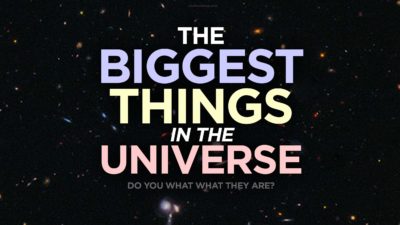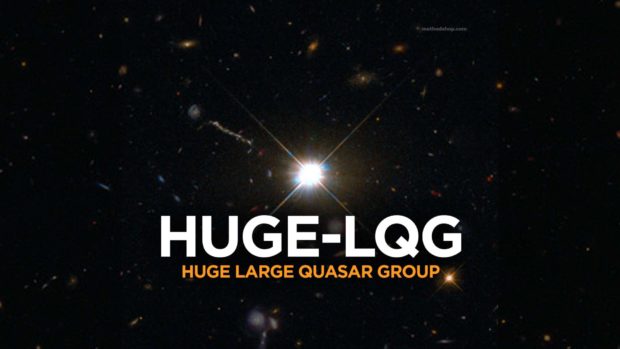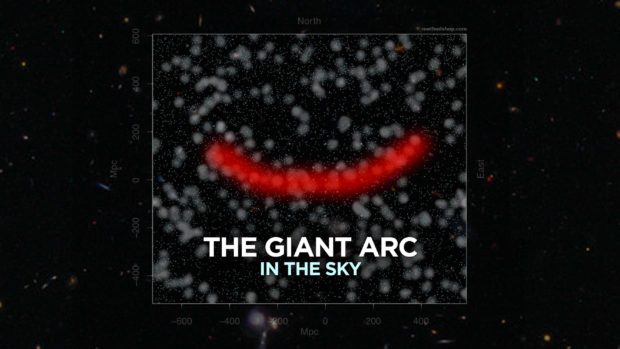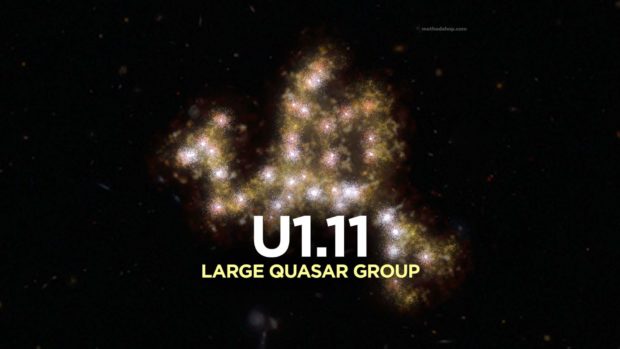From(Amazon link) The Great Barrier Reef (Earth’s largest structure) to the blue whale (our largest mammal), we are surrounded by giant things right here on Earth. But what about space? Our solar system, the Milky Way Galaxy and beyond? Are there supermassive terrestrial planets, massive black holes, supergiant massive stars or other large celestial objects out there?
Here’s a list of the biggest things in the Universe. Spoiler alert, they are all massive galactic superclusters.
Top 5 Biggest Things In The Universe Share on XHercules-Corona Borealis Great Wall
What is the single biggest thing in the universe? It is by far, the Hercules-Corona Borealis Great Wall. Officially known as a galactic filament, this group of multiple gravitationally linked galaxy superclusters, was first discovered in November 2013. Astronomers estimate that the Hercules-Corona Borealis Great Wall is about 10 billion light-years away from Earth and 10 billion light-years across. It’s so big that astronomers were only able to estimate the celestial object’s massive size by mapping gamma-ray bursts.
NERD NOTE: A light-year is a measure of distance, not time. One light year is the total distance that a beam of light, moving in a straight line, travels in one year. To obtain an idea of the size of a light-year, take the circumference of the earth (24,900 miles), lay it out in a straight line, multiply the length of the line by 7.5 (the corresponding distance is one light-second), then place 31.6 million similar lines end to end. The resulting distance is almost 6 trillion miles (6,000,000,000,000).
The Giant GRB Ring
Consisting of 9 gamma-ray bursts (GRBs) the Giant GRB Ring was first discovered in 2015 by a research team using the telescopes aboard the Swift Spacecraft observatory. Located about 9.1 billion light years from Earth, the giant celestial object is about 5.6 billion light years wide.
The Huge-LQG
Although it’s over 4 billion years wide, the Huge-LGQ (Huge Large Quasar Group) is currently only the third-largest thing in the observable Universe. First discovered in 2012, the Huge-LQG is a pseudo-structure consisting of 73 distant quasars.
The Giant Arc
Located 9.2 billion light years away from Earth, The Giant Arc is 3.3 billion light years wide and was just recently discovered in 2021. It consists of galaxies, clusters of galaxies, and plenty of gas and cosmic dust. We can’t see The Giant Arc with the naked eye, but if we could, it would be the width of approximately 20 full moons.
U1.11 LQG
Last, but not least, the awkwardly named U1.11 is a large quasar group with an estimated diameter of 2.2 billion light-years. Located about 8.8 million light-years away from Earth, it was discovered in 2011 during the Sloan Digital Sky Survey. U1.11 contains 38 quasars and galactic nuclei with supermassive black holes.
Have You Heard Of These Giant Superclusters Before?
Unless you are actively involved in the space industry or astronomy, the objects on this list probably won’t be all that familiar to you. Thanks to advancements in space astronomy equipment, all the biggest things in the Universe on this list were all discovered after the year 2010.
Top 5 Biggest Things In The Universe Share on XOther Big Things In The Universe (Besides Galactic Superclusters)
Beyond these massive galactic superclusters, there are other big things and large objects in the observable universe. What are the biggest stars, black holes and other giant objects out there?
- Largest Star: UY Scuti is a hypergiant star with an incredibly large radius that’s estimated to be 1,700 times larger than the sun. It is by far the biggest star in the universe and guaranteed to give you a major skin-melting sunburn if you go anywhere near it.
- Largest Black Hole: TON 618 is believed to be the largest black hole in the universe. Its estimated mass is estimated to be the equivalent of 66 billion of our suns.
- Largest Exoplanet: First discovered in 2005, GQ Lupi B is a brown dwarf star extrasolar planet outside our solar system. Even though it’s a star (aka sun), it is orbiting another star, GQ Lupi. Imagine that, a star orbiting another star. What if a smaller sun was also orbiting our Sun along with the rest of the planets in our solar system? Would it ever fully get dark at night?
- Largest Galaxy: IC 1101 is a supergiant elliptical galaxy that contains an estimated 100 trillion stars. At the center of IC 1101 is an ultramassive black hole with an estimated mass range of 40–100 billion times greater than our Sun.
- Largest Nebula: Spanning more than 1,800 light-years wide in its longest part, The Tarantula Nebula is the largest known nebula in our universe.
- Largest Volcano: There are likely much bigger volcanos in the universe, but the biggest one that we know about right now is Olympus Mons on Mars. It is roughly 15 miles high and three times taller than Earth’s Mount Everest. Just imagine trying to hike that!
- Largest Magellanic Cloud: Located 170,000 light-years away from Earth, the largest magellanic cloud is simply called the Large Magellanic Cloud (LMC). This small satellite galaxy is currently about 160,000 light-years away from Earth, but not for long. The LMC and The Milky Way are on a collision course. In about 2.4 billion years, they will merge. Yikes!
Will Humanity Ever Be Able To Visit The Biggest Things In The Universe?
So what did we learn here? As much as we might want the biggest things in the Universe to be giant space creatures or super planets, they are all massive galaxy clusters. But hey, that’s still really cool.
Maybe someday we will have the ability to easily explore the universe, like in Star Trek. Sadly, humanity won’t be visiting any of the biggest things in the Universe anytime soon. The Hercules-Corona Borealis Great Wall is 10 billion light years, or about 60,000,000,000,000,000,000,000 sextillion miles away.
To help put a distance that great in perspective, let’s compare it to one of the longest flights on Earth. The 18-hour-long New York City to Singapore flight travels a total distance of 9,450-miles. Assuming that you took this flight every day of your life, and that you lived to be 80 years old, that’s still only a total of 275,940,000 million lifetime miles traveled.
Based on that assumption, it would take 217,438,573,602,957 trillion lifetimes to travel 10 billion light years to reach the Hercules-Corona Borealis Great Wall. Once there, you might as well travel the entire supercluster from end to end. That’s another 217 trillion lifetimes but just think about all the clusters of galaxies along the way. With the excursion now complete, let’s go home. Unfortunately, it will take another 217 trillion lifetimes to return to Earth.
But if you’re looking for a shorter trip, our spiral galaxy, the Milky Way, is only about 100,000 light-years, or 600 quadrillion miles wide.
That’s still one massive road trip!
What is the biggest thing in #space? Do you know what the biggest things in the Universe are? ... #spacetravel #spaceforce #astronaut #astronomy #astrophotography #galaxy #stars #nasa Share on XNERD NOTE: The prevailing theory behind the creation of the observable universe is the Big Bang Theory. This cosmological model explains our universe from its initial creation through its evolution over billions of years.

Frank Wilson is a retired teacher with over 30 years of combined experience in the education, small business technology, and real estate business. He now blogs as a hobby and spends most days tinkering with old computers. Wilson is passionate about tech, enjoys fishing, and loves drinking beer.




























 14 Famous Anti-Vaxxers Who Died Of COVID-19
14 Famous Anti-Vaxxers Who Died Of COVID-19
Leave a Reply
You must be logged in to post a comment.